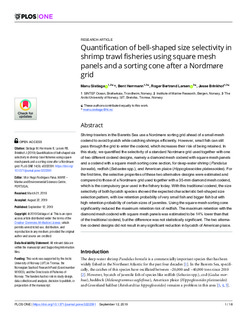| dc.description.abstract | Shrimp trawlers in the Barents Sea use a Nordmøre sorting grid ahead of a small-mesh codend to avoid bycatch while catching shrimps efficiently. However, small fish can still pass through the grid to enter the codend, which increases their risk of being retained. In this study, we quantified the selectivity of a standard Nordmøre grid used together with one of two different codend designs, namely a diamond mesh codend with square mesh panels and a codend with a square mesh sorting cone section, for deep-water shrimp (Pandalus borealis), redfish (Sebastes spp.), and American plaice (Hippoglossoides platessoides). For the first time, the selective properties of these two alternative designs were estimated and compared to those of a Nordmøre grid used together with a 35-mm diamond mesh codend, which is the compulsory gear used in the fishery today. With this traditional codend, the size selectivity of both bycatch species showed the expected characteristic bell-shaped size selection pattern, with low retention probability of very small fish and bigger fish but With high retention probability of certain sizes of juveniles. Using the square mesh sorting cone significantly reduced the maximum retention risk of redfish. The maximum retention with the diamond mesh codend with square mesh panels was estimated to be 14% lower than that of the traditional codend, but the difference was not statistically significant. The two alternative codend designs did not result in any significant reduction in bycatch of American plaice. | |
